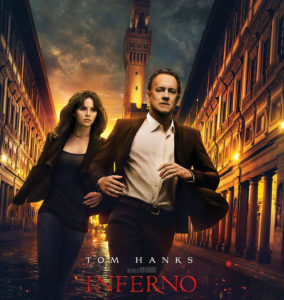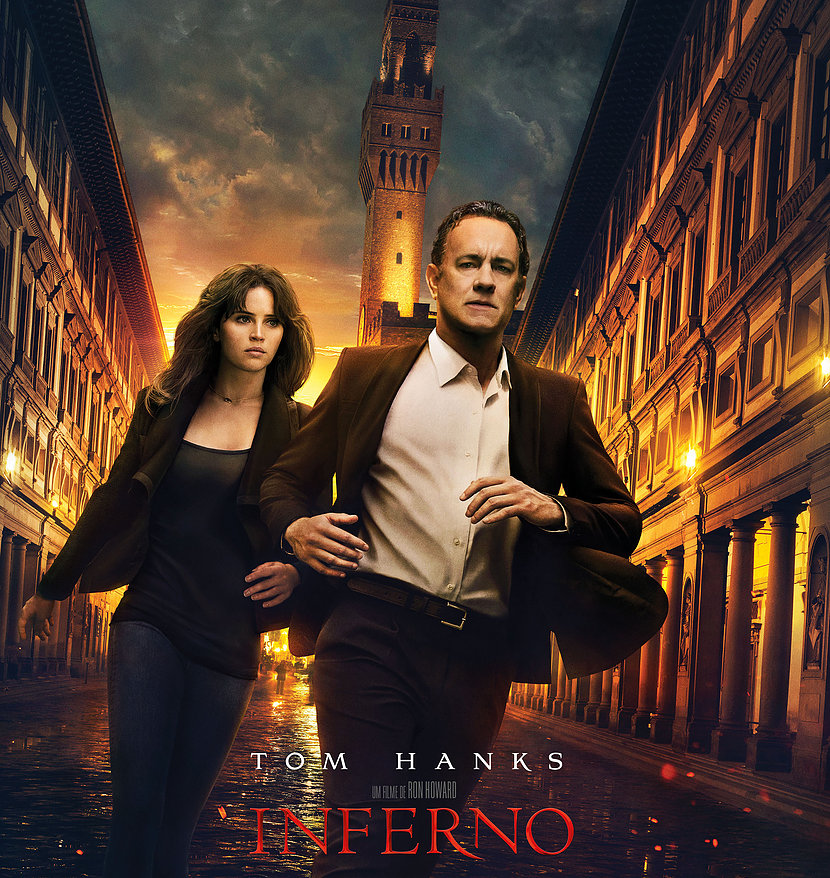
When Robert Langdon wakes up in an Italian hospital with amnesia, he teams up with Dr. Sienna Brooks, and together they must race across Europe against the clock to foil a deadly global plot.
Director: Ron Howard
Starring: Tom Hanks, Felicity Jones, Irrfan Khan
Rated PG-13 for sequences of action and violence, disturbing images, some language, thematic elements and brief sensuality
It’s been seven years since we last saw Professor Robert Langdon sprinting across Europe, uncovering religiously diabolical plots with global implications. “Inferno,” adapted from the fourth novel in author Dan Brown’s Robert Langdon series, is interestingly the third film installment of the series. In Ron Howard’s “The Da Vinci Code,” perhaps the most controversial film of the 2000s, Langdon and company investigated a murder inside the Louvre related to a secret society whose existence could expose a dark secret regarding the origins of Christianity. Its sequel, “Angels and Demons,” also directed by Ron Howard and released three years later, saw the professor racing against the clock to prevent a terrorist attack against the Vatican by yet another secret society, thought extinct for ages. However, in the third – and hopefully final – film, “Inferno,” things start off rather unexpectedly. Previously, Langdon had been approached and asked to assist in investigating the two cases from “The Da Vinci Code” and “Angels and Demons,” respectively. Here, however, the film begins with Langdon waking up in a hospital, with absolutely no idea where he is or why he’s there. Suddenly, his room is ambushed by a female assassin, and it becomes quite clear that he is involved in something quite serious. From this point on, the film seeks to answer how he arrived in the hospital, and most importantly, why.
Instead of adapting author Dan Brown’s third novel, “The Lost Symbol,” successor to “The Da Vinci Code” and “Angels and Demons,” Sony Pictures decided to produce Brown’s fourth novel, “Inferno,” after production fell through for what was supposed to be an adaptation of the third. For whatever reason, director Ron Howard – yes, that Ron Howard, who starred in “The Andy Griffith Show,” “Happy Days,” and “American Graffiti,” and the one responsible for directing such notable titles as “The Paper,” “Apollo 13,” “A Beautiful Mind,” “Cinderella Man,” “Frost/Nixon,” and “Rush” – decided to return as director, while Tom Hanks chose to reprise his role as Langdon. This is interesting, since the adaptation for “The Lost Symbol” failed because Howard refused to direct it and Hanks did not want to return. Hanks, who was unusually distant in “The Da Vinci Code,” but gave a stellar performance in “Angels and Demons,” does all he can to make Langdon’s bizarre situation seem credible. Howard’s direction is quite artistic here. With “The Da Vinci Code” and “Angels and Demons,” Howard played it safe and presented a relatively straightforward narrative. With “Inferno,” Howard throws in apocalyptic visions and some interesting cinematography, presenting a more creative take on an already off-putting story, for better or worse.
Once the plot twists of “Inferno” are out of the way, the film loses all credibility. These “twists” are terribly executed, and insult the intelligence of Professor Langdon. The ending is absurd, and deviates from Brown’s novel with catastrophic results. At times, “Inferno” feels like a love story, and sometimes it comes off as a retread of the first film, highlighting the key action sequences and frantic pacing, but nothing more. “Inferno” doesn’t work, largely in part because of poor character development, but the main detractor would undoubtedly be the screenplay, written by “Angels and Demons” veteran David Koepp. Koepp takes the mystery out of “Inferno” and replaces it with an overload of convention and formulaic plot points, ignoring Brown’s execution and deliberate pacing, instead attempting to recreate an action film reminiscent of “National Treasure.” Interestingly, another key reason that the adaptation of Brown’s “The Lost Symbol” was halted was because the studio feared its story would be compared to “National Treasure.” Thanks to Koepp, the style and tone is all too reminiscent.
Perhaps “The Lost Symbol” book will never make it to the big screen. “Inferno” has done poorly at the box office, more so than the studio predicted. “Inferno” was originally expected to top the box office during its opening weekend, but landed in second place behind “Boo! A Madea Halloween.” The release date of the film was changed twice. It was initially slated for release on Dec. 18, 2015, but was moved to avoid competition with “Star Wars: The Force Awakens.” Incredibly, the date was then moved to Oct. 14, 2016, nearly a year later. This date was then changed to Oct. 28, 2016.
Watching “Inferno” is a frustrating experience, to say the least. Tom Hanks’ performance and Ron Howard’s direction fail to save the film. In fact, some parts of the film are unintentionally funny, most notably when Langdon has a vision of a colleague being bitten on the neck by a snake. There also a love story thrown in that feels incredibly forced and artificial; the dialogue here is a nightmare. Simply put, this film is a gigantic mess. Not only is “Inferno” a terrible film, but it’s also quite possibly one of the dumbest movies of the decade, and an insult to any talent that Dan Brown holds.

